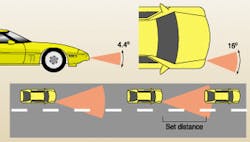
In the automobile industry, optoelectronics is leading the way in the quest for safety and convenience. At auto shows this year in Detroit, MI, and Chicago, IL, car makers showcased a variety of cutting-edge optoelectronic devices in an effort to woo consumers with convenience and ease.
One such device is the adaptive cruise-control (ACC) system, which uses laser beams (lidar) or radar to monitor the distance and speed of one vehicle in front of another vehicle, and to speed up or slow down to maintain a constant distance. The system works much like a conventional cruise-control system to maintain the vehicle at a fixed speed set by the driver; however, if the vehicle in front slows down or a vehicle moves in front from another lane, the system reduces engine speed or in some cases, actually applies the brakes to match the slower speed (see Fig. 1). If the space in front of the ACC-equipped vehicle opens up again, the system will accelerate to match the operator's previous speed setting.
In October 2000, Lexus (Torrance, CA), a division of Toyota, was the first company to introduce laser-based "Dynamic Cruise Control" in the United States. Infiniti (Gardena, CA), a division of Nissan, joined Lexus this year with the introduction of "Intelligent Cruise Control" in 2002 models. The Infiniti models are expected on the lot in November, according to Eric Booth, Infiniti spokesperson.
Nissan's ACC laser sensor, manufactured by Omron (Komaki City, Japan), uses an 860-nm pulsed laser diode. Although manufacturers are reluctant to reveal details of the technology, the laser is likely to be gallium aluminum arsenide-based. A scanning beam is produced with a distance accuracy of up to 130 m. The distance of objects is calculated by the time delay between the transmitted beam and receipt of the reflected beam. Velocity is calculated by differentiating the distance.
Delphi Delco Electronics (Kokomo, IN) offers details of a similar lidar ACC system. Delphi's "Forewarn" adaptive cruise control uses a 905-nm, pulsed gallium arsenide-based laser diode and electronic switched-beam scanning. Sixteen forward channels and a 16-beam laser receiver detect up to 15 targets in heavy traffic up to 150 m away. Velocity and direction of travel are calculated and processed in milliseconds, thanks to digital-signal processing chips developed in the past few years. The system measures only 5 x 10 x 11 cm—about the size of a sandwich.
Radar-based ACC systems have also made an appearance on auto lots. German automaker Mercedes has offered radar-based ACC in the United States since July 2000.1 Although lidar is less costly to produce and less bulky, proponents of radar-based ACC say that laser systems do not penetrate far enough through fog and rain to make them useful when drivers need them most. In clear weather, the Lexus lidar system has a range of 120 m. However, the system shuts off upon detection of poor conditions.
Other optoelectronics in the mix
Other new uses of optoelectronics are appearing in autos. In addition to the "Intelligent Cruise Control" system, the 2002 Infiniti Q45 and QX4 sport utility vehicle also incorporate a massive, seven-lens high-intensity-discharge (HID) xenon headlamp system that the company claims is the most powerful in the business, effectively obviating the need for separate fog lamps (see Fig. 2). An optional rear-view video camera mounted near the license plate gives the view behind the car when it's in reverse.A concept car introduced this year, the Infiniti FX45 combines several optoelectronic devices, including the HID headlamps and ACC system. The dashboard of the FX45 features a 9.5-in. flat-panel liquid-crystal display for speedometer, tachometer, navigation, audio system, and climate controls. A game system presents DVD video for backseat passengers.
Sweden-based Volvo is working on a new concept in comfort using infrared eye-sensor technology to automatically adjust seat position of an individual in seconds. Volvo's "Eyecar" is currently touring on the auto show circuit.
REFERENCE
- W. D. Jones, IEEE Spectrum 9, 40 (2001).
About the Author
Valerie Coffey-Rosich
Contributing Editor
Valerie Coffey-Rosich is a freelance science and technology writer and editor and a contributing editor for Laser Focus World; she previously served as an Associate Technical Editor (2000-2003) and a Senior Technical Editor (2007-2008) for Laser Focus World.
Valerie holds a BS in physics from the University of Nevada, Reno, and an MA in astronomy from Boston University. She specializes in editing and writing about optics, photonics, astronomy, and physics in academic, reference, and business-to-business publications. In addition to Laser Focus World, her work has appeared online and in print for clients such as the American Institute of Physics, American Heritage Dictionary, BioPhotonics, Encyclopedia Britannica, EuroPhotonics, the Optical Society of America, Photonics Focus, Photonics Spectra, Sky & Telescope, and many others. She is based in Palm Springs, California.

